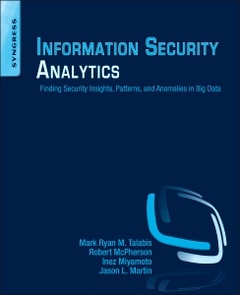Information Security Analytics Finding Security Insights, Patterns, and Anomalies in Big Data
Auteurs : Talabis Mark, Martin Jason, McPherson Robert, Miyamoto Inez

Information Security Analytics gives you insights into the practice of analytics and, more importantly, how you can utilize analytic techniques to identify trends and outliers that may not be possible to identify using traditional security analysis techniques.
Information Security Analytics dispels the myth that analytics within the information security domain is limited to just security incident and event management systems and basic network analysis. Analytic techniques can help you mine data and identify patterns and relationships in any form of security data. Using the techniques covered in this book, you will be able to gain security insights into unstructured big data of any type.
The authors of Information Security Analytics bring a wealth of analytics experience to demonstrate practical, hands-on techniques through case studies and using freely-available tools that will allow you to find anomalies and outliers by combining disparate data sets. They also teach you everything you need to know about threat simulation techniques and how to use analytics as a powerful decision-making tool to assess security control and process requirements within your organization. Ultimately, you will learn how to use these simulation techniques to help predict and profile potential risks to your organization.
Chapter 1: Analytics Defined
Chapter 2: Primer on Analytics Software and Tools
Chapter 3: Analytics and Incident Response
Chapter 4: Simulations and Security Processes
Chapter 5: Access Analytics
Chapter 6: Technical Risk Profiling
Chapter 7: Security Intelligence and Next Steps
He is co-author of the book "Information Security Risk Assessment Toolkit: Practical Assessments through Data Collection and Data Analysis" from Syngress. He has presented in various security and academic conferences and organizations around the world including Blackhat, Defcon, Shakacon, INFORMS, INFRAGARD, ISSA, and ISACA. He has a number of published papers to his name in various peer-reviewed journals and is also an alumni member of the Honeynet Project.
He has a Master of Liberal Arts Degree (ALM) in Information Technology from Harvard University and a Master of Science (MS) degree in Information Technology from Ateneo de Manila University. He holds several certifications including a Certified Information Systems Security Professional (CISSP); Certified Information Systems Auditor (CISA); and Certified in Risk and Information Systems Control (CRISC).
Jason Martin is Vice President of Cloud Business for FireEye, Inc. the global leader in advanced threat detection technology. Prior to joining FireEye Jason was the President and CEO of Secure DNA (acquired by FireEye), a company that provided innovative security products and solutions to companies throughout Asia-Pacific and the US Mainland. Customers included Fortune 1000 companies, global government agencies, state and local governments, and private organizations of all sizes. Mr. Martin has over fifteen years of experience in Information Security, is a published author and speaker, and is the co-founder of the Shakacon Security Conference.
Robert McPherson leads a team of data scientists for a Fortune 100 Insurance and Financial Service company in the US. He has 13 years o
- Written by security practitioners, for security practitioners
- Real-world case studies and scenarios are provided for each analytics technique
- Learn about open-source analytics and statistical packages, tools, and applications
- Step-by-step guidance on how to use analytics tools and how they map to the techniques and scenarios provided
- Learn how to design and utilize simulations for "what-if" scenarios to simulate security events and processes
- Learn how to utilize big data techniques to assist in incident response and intrusion analysis
Date de parution : 11-2014
Ouvrage de 182 p.
19x23.4 cm
Thèmes d’Information Security Analytics :
Mots-clés :
Access analytics; Arena; Big data; Conceptual model; Control limits; Correlation; CRAN; CSV; Databases; Descriptive statistics; Distributed file system; Evaluating performance; Excel; Hadoop; Hive; Hive query language; HQL; JSON; Knowledge engineering; Logistic regression; Machine learning; Mahout; MapReduce; MaxMind GeoIP; Neural networks; Outlier detection; Outliers; Pig; Principal components analysis; Privacy; Programming detection strategies; Python; R; Relational database; Remote access technologies; Risk management; Scripting; Security analytics; Security intelligence; Server logs; Simulations; Software; SQL; Standard deviation; Statistics; Stop word list; Structured data; Structured query language; Supervised learning; Support vector machines; Text mining; Time series; Token; Tools; Unstructured data; Unstructured text; Unsupervised learning; Virtual private network; VPN; XML; Z-score



